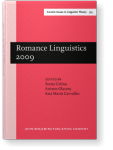The production and provenance of palatal nasals in Portuguese and Spanish
We present acoustic evidence bearing on the articulation of the palatal nasal consonants in Portuguese and Spanish. We outline the etymological origins of these consonants, some of which are shared by the two languages. One class of Portuguese palatal nasals arose from a nasalized palatal approximant – the phonetic leftovers of a historical process (typical of Galician-Portuguese but not Spanish) that nasalized vowels and deleted intervocalic alveolar nasal consonants. Some descriptions of Brazilian Portuguese suggest that this nasalized approximant is still extant and perhaps even dominant among speakers of the modern language. We compare the articulation of palatal nasals in a variety of vocalic contexts to determine the degree of impedance. We find evidence suggesting that the nasalized approximant of medieval Galician-Portuguese may have been retained in Brazilian Portuguese. This highly conservative trait appears to have spread throughout the lexicon even to etymologically unrelated forms and may be the reason for attested asymmetries in coarticulation among BP nasal consonants.
Cited by (1)
Cited by one other publication
Shosted, Ryan, José Ignacio Hualde & Daniel Scarpace
2012.
Palatal Complexity Revisited: An Electropalatographic Analysis of /ɲ/ in Brazilian Portuguese with Comparison to Peninsular Spanish.
Language and Speech 55:4
► pp. 477 ff.

This list is based on CrossRef data as of 27 july 2024. Please note that it may not be complete. Sources presented here have been supplied by the respective publishers.
Any errors therein should be reported to them.
